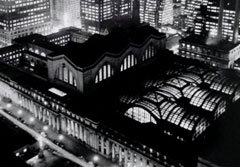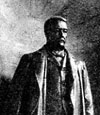An Uncommon Businessman -- Alexander Cassatt and the Building of Penn Station A hundred years ago--November 27, 1910 to be exact--the principle arch of triumph on a long "Broad Way" of engineering marvels was opened. This was Pennsylvania Station in New York City. One of the few components of the original plant that survive today is the Farley Post Office Building on which are inscribed Herodotus' words about Persian couriers: "Neither snow nor rain nor heat nor gloom of night stays these couriers from the swift completion of their appointed rounds." Penn Station was a gorgeous building of tavertine modelled on the Roman Baths of Caracalla, but in its conception there was a flaw. The designers and builders did not take into account the pressure in New York City to build real estate skyward. In the mid 1960s, the station's lateral grip on several city blocks was broken and its site is currently that of the latest Madison Square Garden. The loss of the grand structure is certainly near the top of historical preservationists' list of travesties. Unprecedented were the tunnels under the Hudson and East Rivers which made Penn Station possible. Many times, boring the horizontal holes through various geographic obstacles brought the builders close to despair. The tubes were opened with the hope that the first or second or thousandth train running through them wouldn't cause them to fail. After a hundred years they rest unanchored on the river bottom like hoses that roll a little with the river current. Other things that had to be invented from scratch were the electric locomotives that took charge of the trains from steamers at Manhattan Transfer and hauled them under the waters. The power it took to build the first railroad under the rivers and through Manhattan was titanic strength of the kind that built pyramids and Roman empires. Fortunately, it was power in the hands of benevolent men who had pride in their work. It's hard to imagine a company today wanting to be a model of excellence in everything it does simply because being excellent gratis excellentiae builds civilization. Business education is worthless in producing corporate leaders with noble impulses and ultimately worthless in any regard. Being suited to rule has always been a rarity among business executives. In the 19th Century most were like Franklin B. Gowen, the Scotch-Irish Presbyterian president of the Reading railroad and coal companies who thought it was so much the better if Irish Catholics were worked to death while he made piles of money. However, leading the Pennsylvania Railroad as it laid siege to and conquered Manhattan was a man well-qualified to hold thousands of lives in his hands: Alexander J. Cassatt. He was born into wealth and refinement, experiencing none of that clawing for survival and respect that turns into ruthlessness (and looniness). He studied in Germany while his sister, Mary went off to Paris to paint pictures. Although he had the advantages of a rich boy, Cassatt started working at the bottom of the PRR totem pole, as a dollar-a-day surveyor's assistant. As he rose in the PRR's ranks, he learned everything about running a railroad. Cassatt ordered the Pennsylvania militia to fire on rioting railroad workers as they burned down Pittsburgh in 1877. However his eyewitness of that destruction awoke him to the fact that the employees of his company had been pushed over the edge. While other railroad execs dismissed as too expensive safety inventions such as Westinghouse's braking system and Janney's coupler which saved railroad workers from being maimed and crushed between cars, Cassatt spent the money on them. In building Penn Station in what had been New York's Tenderloin of whorehouses etc., Cassatt refused to pay "boodle" to Tammany and miraculously managed to avoid doing so. Although William Randolph Hearst chose to pick on him, depicting him as another trust-building plutocrat, Cassatt agreed with President Theodore Roosevelt that "you could not have a healthy industrial democracy if the rich rigged the system to become even richer and bigger. Only the government had the power to tame the trusts." (1) Pennsylvania Railroad presidents were wealthy men who made fabulous salaries, but working for the PRR tended to kill them. Cassatt died in office four years before the first clean-running, quiet electric train pulled into his grand terminal. Therein he was memorialized in a bronze statue until the station itself was felled. Fortunately monuments of lesser grandeur to him remain along the former Pennsylvania Railroad's "Broad Way" (now Amtrak): Union Station in Washington, DC, Penn Station in Baltimore and numerous other structures such as the bridge across the Susquehanna at Havre de Grace, Maryland. They all stand as rocks as hundreds of trains and hundreds of thousand of people pass through them every day. (1) from Conquering Gotham: Building Penn Station and Its Tunnels, by Jill Jonnes, Penguin Books, 2007, p. 197. |
 |
|---|
 |
 |
 |
 |
 |
|---|
Copyright 2010 by Neal J. Conway. All rights reserved.